This website uses cookies
This website uses cookies to enable it to function properly and to analyse how the website is used. Please click 'Close' to accept and continue using the website.


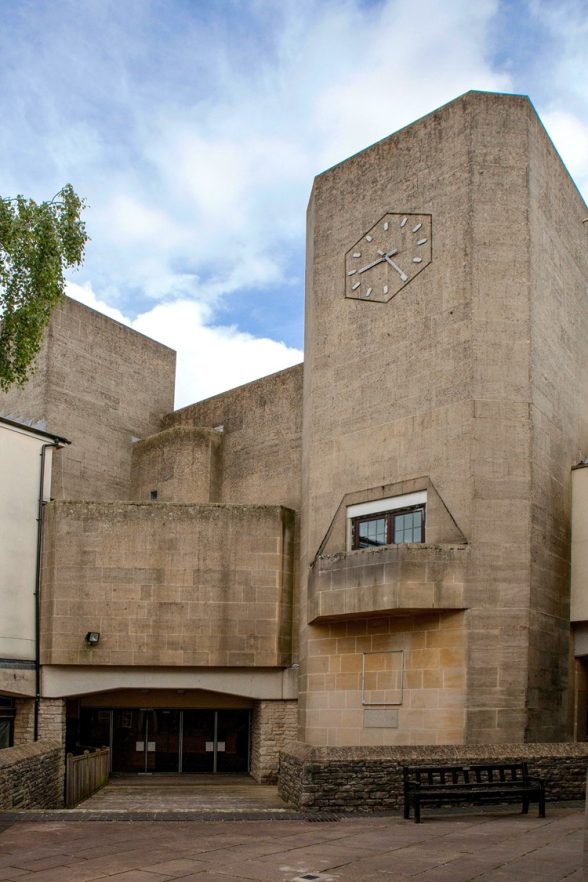
Image credit: OBNW
C20 Society has backed proposals by a local community organisation to buy, restore and reopen the former Amulet Theatre in Shepton Mallet, Somerset. It comes amid news of a grant awarded by the Theatres Trust and new scheme developed by Ian Chalk Architects, to enable meanwhile use of the significant brutalist-style building ahead of a proposed full restoration.
Opened in 1975, the Amulet was a gift to the people of Shepton Mallet by the local industrialist and brewer Francis Showering (inventor of Babycham), and was designed by regionally based practice the Wyvern Design Group. A state-of-the art theatre and multi-purpose venue for the whole community, it formed part of a wider, privately-led, £1.5 million scheme for the reconstruction of an important town centre site. The Amulet is a striking and well-designed complex of buildings on a constrained site which, though essentially modernist in spirit, respond well to their historic location (a designated Conservation Area) in terms of form, materials and style.
Internally, the architects sought to achieve maximum flexibility and to create a multi-use art centre that doubled as a community centre, building on earlier traditions such as the village hall. The provision of a 270-seat auditorium included a motorised retractable seating system that lifts vertically into the ceiling to reveal a sprung dance floor below, thought to be the only one of its kind in the UK. A scenery fly tower and two-storey artist dressing rooms are further notable features, that distinguish the building as a highly unusual adaptable theatre in a small town setting.
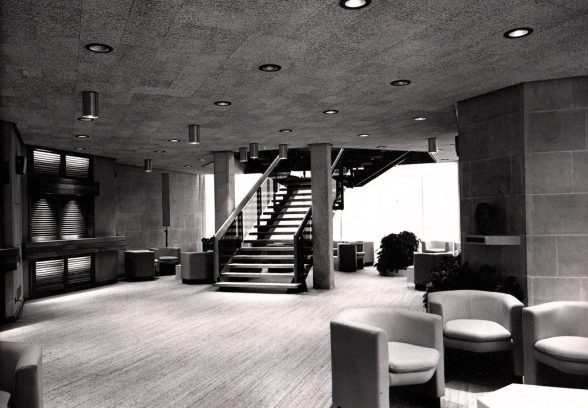
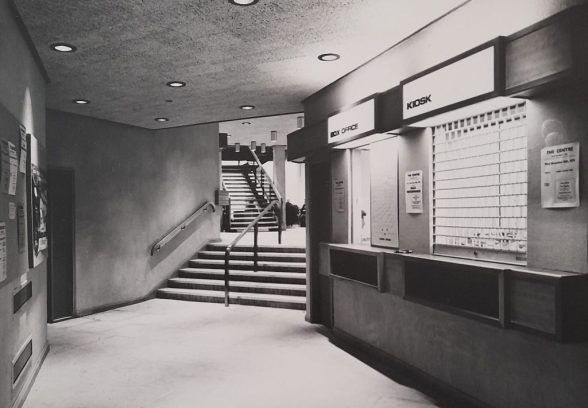
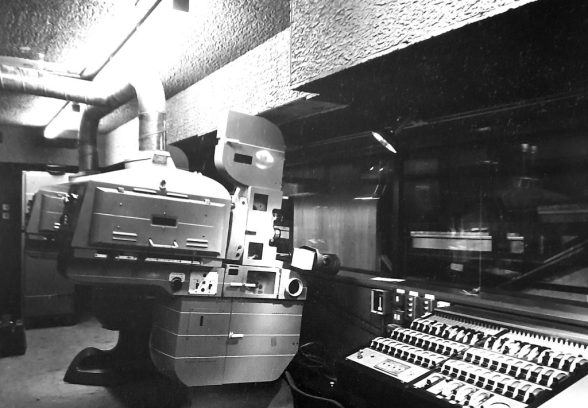
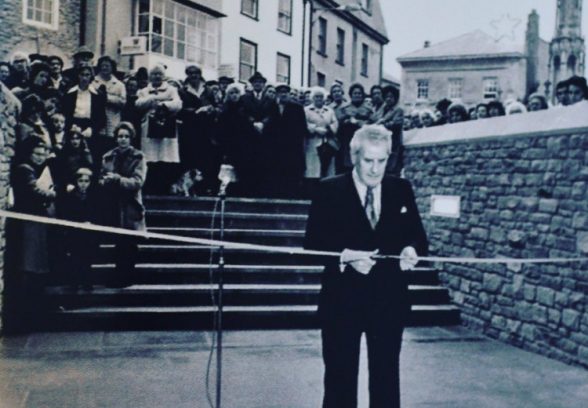
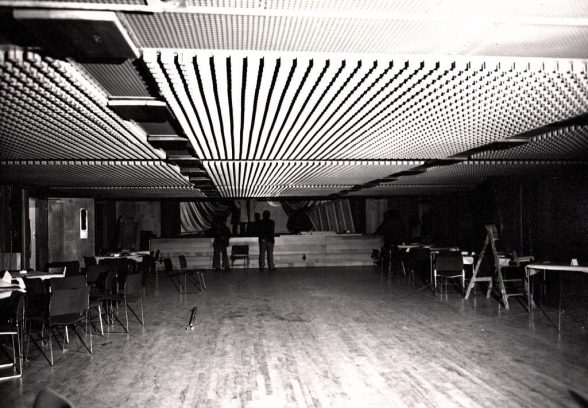
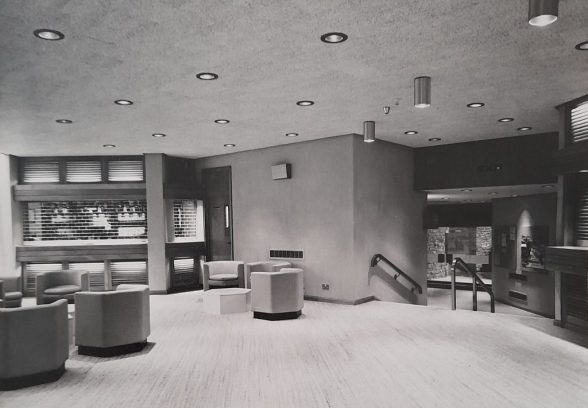
Local campaign group
The building originally hosted theatre, live music, and film screenings; as the only theatre in the town and with limited provision in the wider area, it became an important venue in East Somerset. The Amulet was acquired by the Bristol Academy of Performing Arts (BAPA) in the mid-2000s, who refurbished the building, using it as an education and training centre known as the Academy, with a full programme of public theatre and performance use in the evenings. After BAPA went into administration in 2011, the Amulet was acquired by a private owner and has been closed as a theatre ever since. The auditorium has been in use as a gym, but there is no record of planning permission having been obtained for this use. The building is unlisted.
Spurred by the considerable local interest in reopening the building as a theatre, in 2023 a local not-for–profit campaign group, Let’s Buy the Amulet, was formed, comprising local residents and arts group leaders. During 2024 the group made progress in developing a business case for the future use of the building and exploring funding options that will enable them to purchase the building. The Architectural Heritage Fund awarded a grant of £10,000 to develop a viability study, with the Community Shares Booster Fund awarding a further £10,000 for support in setting up a community business model, including legal registration and launching a community share issue.
The latest grant of £6,000 from the Theatres Trust – who added the building on their Theatres At Risk Register in 2022 – will go towards compliance and planning works, including plans and specifications for building control, fire risk assessment and emergency exit specifications. These crucial first steps will allow ‘meanwhile’ community use activities to take place in the building, while plans are developed to fully restore it as a theatre.
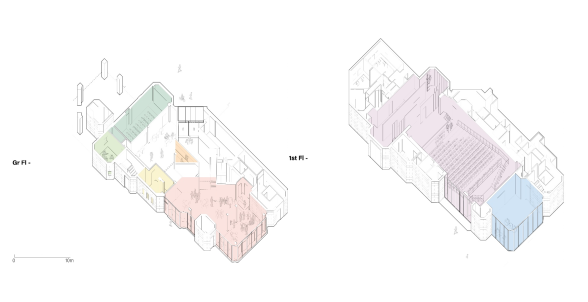
Image credit: Ian Chalk Architects
From meanwhile use to restoration
The Let’s Buy the Amulet group have worked with Ian Chalk Architects to produce a brief and scheme for meanwhile use for the building. This will serve the local population of 11,000 people by providing a public space for numerous daily community activities, with further opportunities for training, volunteering and employment, particularly for young people.
The proposals for the ground floor include reinstating the original reception and office-box layout to enhance flow through to the lobby area, with a cafe/bar area and flexible gallery space to host activities during the daytime and evening, like exercise classes, exhibitions, and workshops. A mini-auditorium of fixed theatre seats would be used for cinema and small theatre shows during the meanwhile phase, with a workspace and meeting room for hosting art classes, community gatherings and music therapy. Longer term the proposals extend to the auditorium, stage and dressing rooms on the first floor, that are currently in use as a gym. Thanks to the seating platform, this would also be a highly flexible space.
Other Ian Chalk projects that have revitalised twentieth century heritage include the transformation of a 1970s brutalist office block into the Standard Hotel in Kings Cross, the restoration of the Art Deco Troxy Cinema in Mile End, and the extension of a 1930 warehouse in Hoxton into Chart Street Studios. Most recently, the practice worked with C20 Society to develop a proposal for The Dunn: a new national skateboarding centre, within the Grade II listed Richard Dunn Sports Centre, in Bradford.
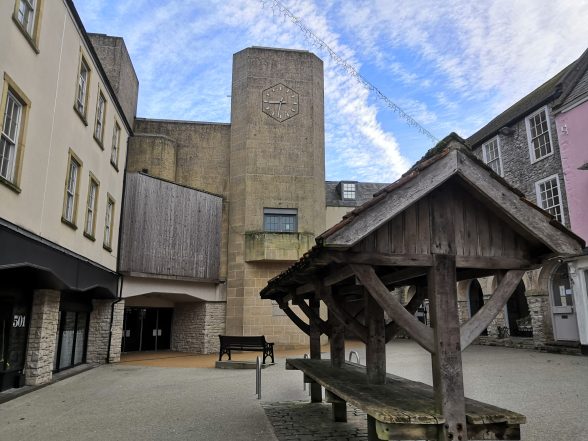
Image credit: Theatres Trust
The post-war theatre boom and Shepton Mallet
Dr Alistair Fair, Reader in Architectural History at Edinburgh College or Art, and a member of C20’s Casework Committee, has written the following appraisal of the Amulet:
The Amulet – originally known as The Centre – was realised amid a wider boom in theatre-building which took in the length and breadth of Britain, and which, between the late 1950s and the early 1980s, saw new theatres constructed in places from Plymouth to Inverness, Aberystwyth to Ipswich. The ‘regional’ location of these venues is significant, for although this is the period of the National Theatre in London (1976), most of the new theatres were outside the largest centres of population. Many were located in smaller towns; others were built on university campuses, including the new greenfield sites of the ‘plate-glass’ universities.
This theatre-building boom was principally supported by public funds, as were, in many cases, the organisations housed in these buildings. The Arts Council of Great Britain was founded in 1945 in order to distribute public subsidies for the arts at ‘arm’s length’ from government, and during the 1950s began increasingly to consider how it might support building projects. During the 1960s, support for capital works was formalised as a dedicated ‘Housing the Arts’ scheme which offered grants, usually 20-30% of construction costs, responsively. In parallel, grant-making bodies such as the Nuffield Trust and the Gulbenkian Foundation made major grants to arts organisations, as did local authorities, whose spending on the arts was enabled by the Local Government Act of 1948.
Within this context, the Amulet is extremely significant and unusual as an entirely privately funded venue. Privately funded theatres were not unknown in this period, with Glyndebourne perhaps the best-known example, but the Amulet’s modest scale and the contextual approach, befitting a historic market town, further underline its outlier status.
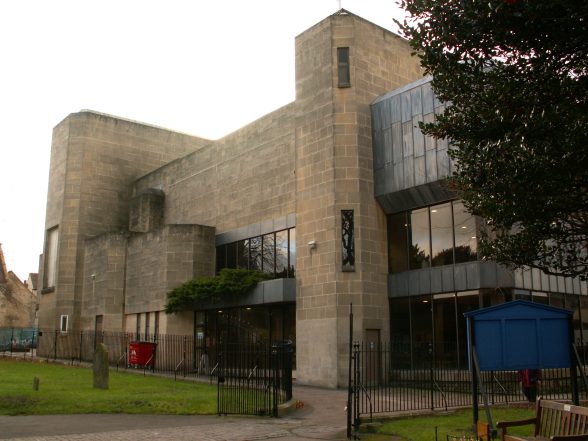
Image credit: Theatres Trust
Comments
Joshua McTaggart, CEO of Theatres Trust:
We added the Amulet Theatre to our Theatres at Risk Register in 2022 in recognition of the theatre’s unique heritage and design, and that there is a genuine need for a theatre and community arts space in Shepton Mallet. This research has further confirmed what an important building the Amulet is, and we are pleased to be supporting The Amulet Centre Limited with its mission to revive it.
Ian Chalk of ICA:
The Amulet is a striking 1975 brutalist theatre, built in local rubble stone and concrete, expertly grafted into the urban fabric of this charming market town. Built to provide a 270-seat auditorium and fly-tower, with multi-purpose spaces for the community, the building is now largely derelict.
Ian Chalk Architects (ICA) are working with the local campaign group ‘ Let’s Buy the Amulet’, to bring this derelict theatre back into meaningful community use. The project could be a transformational, as catalyst for the high street’s wider regeneration.
The project builds on the ICA’s experience of refurbishing 20th century theatres and venues. The practices’ role includes providing strategic guidance, alongside navigating complex technical and compliance matters and promoting the heritage value of this hidden gem.

Become a C20 member today and help save our modern design heritage.